The Mossberg 500 series of shotguns (including: 500, 505, 510, 535, and 590) have been running strong since around 1960, and they seem not to be letting up in any form or fashion.
“Boo-Boo,” my prized Mossberg 500, has been with me since around 1982 or so. “Boo-Boo” began life as an ordinary ‘Persuader’ model with a pistol grip and has seen several renditions in the years that I have owned it. A couple of Mossberg 500 shotguns are in my stable in 20-gauge renderings, one of which would be considered the baby brother to the Mossberg 500 under review here. Other companions to the aforementioned shotguns include a Mossberg 590A1 and a Mossberg 930. There has been a sprinkling of Remington 870 shotguns in 12-gauge and 20-gauge added to the family, but the Mossberg 500 has been the first choice for me, and I am sure, many others when considering home and personal defense shotguns.
When talking about pump shotguns, two usually come to the surface of the debate; Remington and Mossberg. An inclusion of Winchester and Ithaca along with Benelli and Beretta flavor the pot of debate, but usually it is the Mossberg and Remington that is most compared.
I recently, reviewed the Remington 870 “Home Defense” shotgun (https://guntoters.com/blog/2018/07/29/remington-870-home-defense/), which is a definite ‘keeper’ in my book. The primary reason for obtaining the Remington 870 “Home Defense” shotgun was to evaluate its performance with “mini shells.” The Remington 870 “Home Defense” shotgun was declared a winner in that regard.
The Mossberg 500 Tactical shotgun was purchased with the same thing in mind, functioning with “mini shells.” With the Mossberg 500 Tactical shotgun; however, there is a little addition to the shotgun that must be considered; an adapter to load the “mini shells” proficiently and provide 100% feeding of these ‘shorter than the usual 2.75-inch’ shotgun cartridges. There is also a question in my mind, “How well will the adapter perform with standard shotgun shells?” There is the possibility that one would have to step up to a more-powerful loading during an encounter with Mr. Bad Guy if the ‘short shells’ didn’t have the desired impact. But, I’ll present the ‘short-to-standard’ load transition later. For now, let me present the Mossberg 500 Tactical 7+1 shotgun.

Mossberg 500 Tactical in 12-Gauge
THE BASICS:
UPC: 015813505673
Description: MOS 500 TACT 12M/20CB B SYN 8R
Brand: Mossberg
Model: Model 500 Tactical
Type: Shotgun: Pump Action
Caliber: 12-Gauge
Finish: Blue
Action: Pump Action
Stock: Black Synthetic
Sight: Bead (front), ‘Ghost Ring’ (rear)
Barrel Length: 20
Overall Length: 42
Weight: 7 lbs
Capacity: 2.75 7+1
Safety: Ambidextrous Tang Safety
Receiver: Blue, Drilled & Tapped
Chamber: 3
Chokes: Cylinder Bore
Butt Plate: Black Rubber
Features: Sling Swivel Studs, Heat Shield Installed
From the picture and basics above, you can tell that the Mossberg 500 Tactical is a no-nonsense, utility shotgun. This shotgun is not intended to be a ‘safe queen.’ The black synthetic stock and fore-grip blends well with the matte-black finish of the aluminum receiver and barrel.
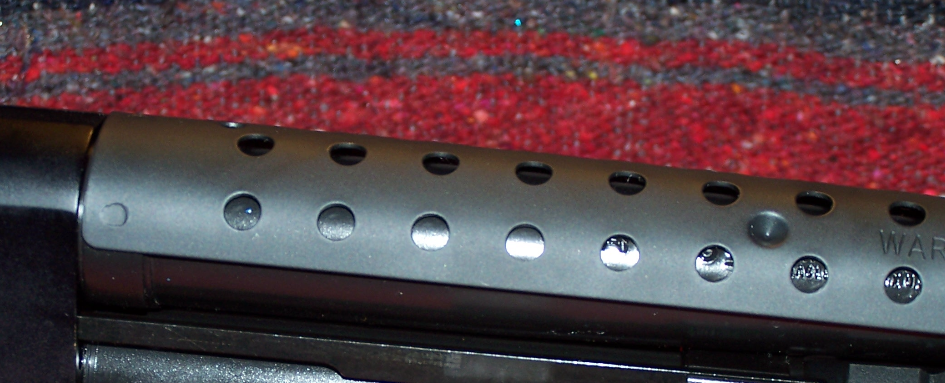
A Heat Shield Protects the 20-inch barrel – and your hands.
The 20-inch barrel, while not as heavy as the barrel found on the 590A1, is more than up to the task of sending shot or slugs downrange. A perforated heat shield, a controversial item in its own right (considered a “Tacti-Cool gadget” by some, it’s an extremely useful device for those who wish to avoid a “barrel branding” when doing inverted reloads (an alternative technique I use when loading from a stock or ‘side-saddle’ shell carrier). IT FITS my needs.), protects the barrel from receiver to the front of the pump handle. When you first pick up the Mossberg 500 Tactical, that 20-inch barrel seems as long as the hood on a 1935 Duesenberg SJ LaGrande Dual-Cowl Phaeton motor car. For that reason, and my weird sense of perspective, I have lovingly named the Mossberg 500 Tactical in 12-gauge as “Deusey.”
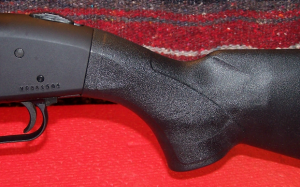
Nicely Textured Stock.
The stock of “Deusey,” you may notice, is a straight-up, standard stock with light texturing. The comb is low enough to provide a good line to the rear sight without scrunching your face to the stock. There is also no ‘tacticool’ happening here. While I have a ‘tacticool’ synthetic stock with pistol grip (also a Mossberg product), and was tempted to mount it on this shotgun, the temptation was suppressed. The provided stock allows me to firmly support the shotgun and easily aim with stability, and that’s all that is needed. There is more on the stock later.
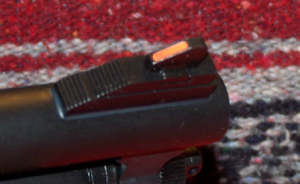
Hi-Vis Orange Front Ramped Sight
The front sight is a raised; ‘High-Vis Orange’ treated ramped post, while the rear sight is a fixed ‘Ghost Ring’ type sight that is adjustable for windage and elevation. The front sight is more than adequate and picks up quickly in the rear sight that, incidentally, is in contrast with the darker finish of the aluminum receiver. While some might say that sights on a shotgun are useless, I find that to be quite the contrary when wanting to place a slug somewhat precisely on a target.

Excellent ‘Ghost” Rear Sight with Elevation and Windage Adjustments.
The receiver is also drilled and tapped to receive a rail to mount an optic. However, the rear sight must be removed to do so. I kept the ‘Ghost Ring’ rear sight on the 20-gauge version, have no issues with it and the rear sight will remain on this 12-gauge version. The rear sight is protected by flared-out side wings. Since the shotgun is intended for close work, the opening of the rear sight is substantial; simply align the front sight post at center in the rear ring horizontally with the top of the sight ramp centered vertically and you have the correct sight alignment picture.
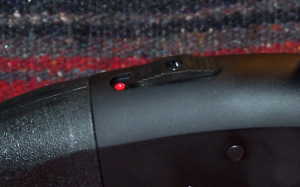
The Best Position for a Safety Button!
The safety button is where I consider it the best possible position for shooters of right or left persuasion, directly centered atop the rear of the receiver. Pull the safety button back for safe, push forward for not safe. That is not to say that the safety button is an easy reach. With the shooting hand high on the grip, the safety button can be reached easily by most. If my shooting hand is low on the grip, I will have to shift my grip to reach the safety. However, I prefer the location of the safety button on the Mossberg more than with other shotguns, especially since I am a left-handed shooter.
!WARNING!
Never lean a a loaded shotgun against anything. The safety only prevents the trigger from moving to the rear; It does not prevent the shotgun from discharging if dropped.
The trigger guard, like the stock and fore arm, is polymer (of course it is). The trigger pull is heavy and slightly gritty when new, as expected on a shotgun of this nature, but it is smoothing out with use. However, take-up is short and release is positive with almost non-detectable over-travel. Let’s face it, a shotgun is not a ‘target grade’ tool and a light, smooth trigger should not be expected out of a shotgun of this nature or price range.
There is plenty of lateral play in the fore-end. Much more, in fact, as compared to the Remington 870 “Home Defense” shotgun that I reviewed earlier, any of my Remington 870 shotguns, and the Winchester 1300 “Defender” that I once had. This is to say that the forearm ‘wobble’ is more pronounced on the Mossberg 500 shotgun than on others, as all have some play. The play in the forearm; however, is due to the loose tolerances of the action bars. “Dual action bars connect the fore-end to the bolt, and generous clearances between the steel action bars and their receiver channels reduce wear on the aluminum receiver while allowing the shotgun to function with the presence of dirt or debris.” – Source: Wikipedia.
As long as the ‘slidey’ part does its job, there is no cause for concern. The play in the forearm of the 20-gauge Mossberg 500 is worse, but it does not affect the operation of the firearm – and that is what matters most.
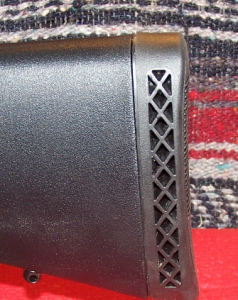
Nice Padding on Butt. I had a LimbSaver for additional LOP.
The Length-Of-Pull (LOP) is 13.5-inches, which is adequate for most folks. For me; however, a LimbSaver slip-on butt-pad adds the extra inch that I need and also helps to buffer some of the recoil the 12-gauge shotgun is known for. Primarily; though, I just need the extra LOP. With the LimbSaver slip-on butt-pad added, the shotgun stock is the perfect length for the butt to fall right into my shoulder pocket when mounted.
The synthetic stock is lightly-textured throughout and is textured the same in the grip area to provide a somewhat non-slip surface. The grip of the stock is substantial enough for a full three-fingered grip. With my hand gripping the shotgun properly, the trigger shoe is right at the first joint of the shooting finger. Some may find the trigger reach too long if they have small hands. For those with small hands, you might want to consider the Mossberg 500 Tactical SPX (Model: 50523) or the Mossberg 500 Tactical w/Adjustable Stock (Model: 50420). Both of these shotguns have a ‘tacticool’ stock/pistol grip combination, but you do lose one round (6+1 vs. 7+1) and 1.5 inches off of the barrel length. Another option would be simply to order a fixed-length stock with pistol grip for the Mossberg 500 Tactical. Personally, and through a bad experience, I do not advocate only a pistol-grip on a shotgun for the average shotgun user. I simply prefer the more stable platform of a full stock, equipped with a pistol-grip or not, for firing from the shoulder or hip. You won’t find a “Shockwave” or pistol-grip only shotgun in my stable. But, that’s just me. (Author’s Note: I just caught myself in a lie when I read this article a lot later. I have invested in the Mossberg “Nightstick” and it is a fine shotgun to be sure.)
Since ‘round capacity’ seems to be a big thing, there is a price to pay. With the Mossberg 500 Tactical that price is the 20-inch barrel, which I would say would be the maximum barrel length for clearing the house while in CQB mode. I find no difference in maneuvering an 18.5-inch barreled shotgun than I do with a 20-inch barreled shotgun in close quarters. A 20-inch barreled shotgun will provide a little more ‘oomph’ for what you are shooting out of the barrel and a little less shot spread at the same distance as it would be for an 18.5-inch barrel. With reduced-power ‘mini shells’ in close quarters, the difference in barrel length will be negligible, in my mind.
The pump handle rides smoothly front and rear, while the dual ‘action bars’ do what they are supposed to do in a positive fashion. The synthetic forearm is well formed to provide a sure grip with or without a gloved hand operating the handle.
The elevator, that device that lifts the new shells from the loading tube, is of an open-base design. While this works well with 2.25-inch ‘mini shells’ and with standard 2.75-inch and 3-inch shells, it does not work well with 1.75-inch fodder; the ‘tab’ on the open elevator is just not long enough to support a 1.75-inch shell. That is where the OPSol® Mini-Clip™ comes into play.
I was so impressed with the OPSol® Mini-Clip™ that I decided to invest in writing a separate article for it, or them I should say. You can read more about the OPSol® Mini-Clip™ at: For now, let’s get back to the Mossberg 500 Tactical in 12-gauge flavoring.
Sling mounts are provided front and rear. The use of which is, of course, optional.
So that is that and it is now time to take the beast to the range, run a few Federal TRUBALL Low Recoil 1-ounce rifled slugs, 00 Buck, and #4 Buck through it, and observe the pattern of the 00 Buck and #4 Buck at ten yards distant. Then, it will be time to experiment with shooting some Nobel Sports 2.25-inch 00 Buck and Aguila 1.75-inch #1 Buck and 7/8-ounce slugs, at the same 10-yard distance, with the OPSol® Mini-Clip™ installed. All of these would be considered ‘Defensive’ loads in my book, and that is what the Mossberg 500 Tactical is all about.
RANGE TIME:
So, let’s first talk about running standard ammunition through the Mossberg 500 Tactical.
Standard Loading and Shooting Observation:
There are no issues running ‘standard-length’ ammunition in the Mossberg 500, nor Nobel Sports 2.25-inch 00 Buck, and I never thought that there would bet. The Federal TRUBALL Low Recoil 1-ounce rifled slugs have a little more felt recoil than a 20-gauge running slugs, but not as much as full-power slugs. Military-grade 00-Buck is also no problem, as is shooting #4 Buck. The shot pattern at ten yards is impressive with both and each would be pretty devastating on a bad-guy or a sheet-rocked wall (or anything else in its path).
It’s time to move on to what I want to use in this shotgun for HD and PD use.
MINISHELL Loading and Observation:
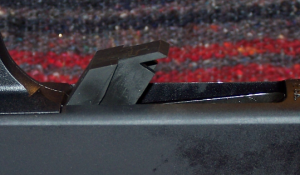
Installing the new OPSOL Mini-Clip 2.0 Flex Adapter.
As I mentioned, an adapter such as the OPSol® Mini-Clip™, is supposed to take the worry out of shooting and ejecting ‘Mini-Shells’ a thing of the past.
With the OPSol® Mini-Clip™ installed, it was time to see if this dog would hunt.
At shooting session’s end the results were as positive as they could be. There were no hang-ups, except when trying to chamber a 1.75-inch mini shell without the

OPSol Mini-Clip Version 2.0 Flex in Place.
OPSol® Mini-Clip™ in place; the end of the shell took a nosedive through the bottom of the elevator. But, that was actually expected. You have to make sure that you don’t baby the shotgun. Extraction must be forceful enough for the ejector to do what it is supposed to do. With standard-length shot shells the expended shells clear the ejection port just fine with normal pumping action. With the shorter shells, a bit more force is needed to ensure that the open end of the expended shell makes it through the ejection port without hanging up on the flared-out open end. Once the front portion of the shell clears the ejection port, everything is fine. With the Remington 870 the shells clearing the ejection port was a bit of a problem at times, but with the Mossberg 500 there were no issues.
Once I had the cycling pattern and effort down, I experienced no issues with running the Aguila 1.75-inch ‘Minishells.’ (you can read more about that in the accompanying article on the OPSol® Mini-Clip™). The felt recoil was such that I could shoot both slug and shot all day. Best of all, the report of the firearm was greatly diminished. While a loud boom is still present, one could shoot these shells indoors without both ears bleeding; something I can’t say for standard-loads, of which I have had to light off indoors without hearing protection and probably is the cause of my deafness. When the ringing in your ears is louder than the voices in your head, you have a hearing problem.
The Aguila Minishells have a weird report. They sound like pebbles running down a hollow pipe, which they in fact are, but the report is not a “solid” as when shooting full-power shells. The report varied from shell to shell, which was kind of weird, but everything made it out of the muzzle, which was expected.
So, the Mossberg 500 Tactical shotgun works wonderfully, and with practice, so does running Min-Shells with the OPSol® Mini-Clip™ installed. If you need the shotgun to work with standard-length shells, simply pop the OPSol® Mini-Clip™ out of the loading port, load up your favorite 2.25”, 2.75” or 3” shells and enjoy the body beating.
THE WRAP-UP
The 12-gauge shotgun has always been, and always will be, a formidable firearm. The flexibility of loadings available for it, including specialty rounds, makes it one of the most transitional firearms available. From Buck to birds, the 12-gauge is capable of handling them all. Firing a 12-gauge; however, may be over-whelming for a lot of folks due to the recoil and loud report of the firearm. For some, that means moving to a 20-gauge that is more forgiving in both respects. However, reduced loadings are available for the 12-gauge that makes it more user friendly for the young and the old without sacrificing defensive capability of the shotgun, although they may not be suitable for hunting. In some cases, in fact, the recoil of the 12-gauge can be less when shooting reduced loads than with the 20-gauge shotgun firing full loads – and this has been proven.
The Mossberg 500 Tactical 12-gauge (or 20-gauge version) will serve you well as a home-defense or personal defense shotgun. I enjoy the ghost rear sight and overall feel of the firearm. Having 7+1 shots at my disposal isn’t going to hurt my feelings and will be felt less than the impact that the shoulder gets when firing standard loads. I also like the location of the safety on the Mossberg line of shotguns; right under my thumb when I need it, as compared to safeties on other shotguns.
And, if you want to run ‘Mini-Shells’ I don’t feel that you will be short-changed (no pun intended. Wait, that was an intended pun!), and you will really enjoy the low-recoil from a still-effective shot shell. Be sure to read the accompanying OPSo® Mini-Clip™ article at: https://guntoters.com/blog/2018/08/26/opsol-mini-clip/
RESOURCES:
Mossberg 500 Tactical, Model 50567: http://www.mossberg.com/product/500-tactical-8-shot-50567/
OPSo® Mini-Clip™: http://www.opsolmini-clip.com/
OPSo® Mini-Clip™ Review: https://guntoters.com/blog/2018/08/26/opsol-mini-clip/
![]()

